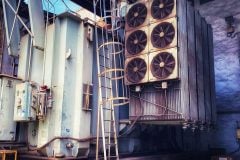Temperature & Insulation
In the U.S., transformers are rated based on the power output they are capable of delivering continuously at a specified rated voltage and frequency under “usual” operating conditions without exceeding prescribed internal temperature limitations.

Insulation is known to deteriorate with increases in temperature, so the insulation chosen for use in transformers is based on how long it can be expected to last by limiting the operating temperature.
Standardization has led to temperatures within a transformer being expressed in terms of the rise above ambient temperature, since the ambient temperature can vary under operating or test conditions.
Transformers are designed to limit the temperature based on the desired load, including the average temperature rise of a winding, the hottest-spot temperature rise of a winding, and, in the case of liquid-filled units, the top liquid temperature rise. To obtain absolute temperatures from these values, simply add the ambient temperature.
Standard temperature limits for liquid-immersed power transformers are listed in Table below.
Standard limits for Temperature Rises Above Ambient
| Temperature rise | Temperature |
| Average winding temperature rise | 65°C ** |
| Hot spot temperature rise | 80°C |
| Top liquid temperature rise | 65°C |
** The base rating is frequently specified and tested as a 55°C rise.
The normal life expectancy of a power transformer is generally assumed to be about 30 years of service when operated within its rating. However, under certain conditions, it may be overloaded and operated beyond its rating, with moderately predictable “loss of life.”
Situations that might involve operation beyond rating include emergency rerouting of load or through-faults prior to clearing of the fault condition.
Outside the U.S., the transformer rating may have a slightly different meaning. Based on some standards, the kVA rating can refer to the power that can be input to a transformer, the rated output being equal to the input minus the transformer losses.
These three segments are:
- Small power transformers: 500 to 7500 kVA
- Medium power transformers: 7500 to 100 MVA
- Large power transformers: 100 MVA and above
Note that the upper range of small power and the lower range of medium power can vary between 2,500 and 10,000 kVA throughout the industry.
It was noted that the transformer rating is based on “usual” service conditions, as prescribed by standards. Unusual service conditions may be identified by those specifying a transformer so that the desired performance will correspond to the actual operating conditions.
Unusual service conditions include, but are not limited to, the following: high (above 40˚C) or low (below –20˚C) ambient temperatures, altitudes above 1000 m above sea level, seismic conditions, and loads with total harmonic distortion above 0.05 per unit.
Reference: Electric Power Transformer Engieneering – Leo L. Grigsby
(Get this book from Google Books)
Copyright Notice
This technical article is protected by U.S. and international copyright laws. Reproduction and distribution of PDF version of this technical article to websites such as Linkedin, Scribd, Facebook and others without written permission of the sponsor is illegal and strictly prohibited.© EEP-Electrical Engineering Portal.
Related electrical guides & articles
Premium Membership
Edvard Csanyi
Hi, I'm an electrical engineer, programmer and founder of EEP - Electrical Engineering Portal. I worked twelve years at Schneider Electric in the position of technical support for low- and medium-voltage projects and the design of busbar trunking systems.I'm highly specialized in the design of LV/MV switchgear and low-voltage, high-power busbar trunking (<6300A) in substations, commercial buildings and industry facilities. I'm also a professional in AutoCAD programming.
Profile: Edvard Csanyi











Transformers need to be properly maintained with respect to the temperatures. Else there will be leakage from coolants that can contribute to various hazards. Thanks for sharing this post!!!
sir i suggest u that explain more about V P D (vapour phase drying plant) the plant perhaps u known r not so plz sir